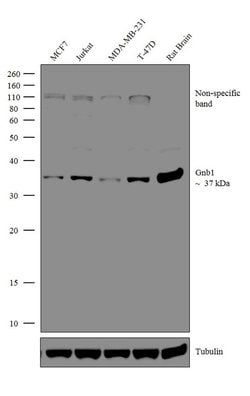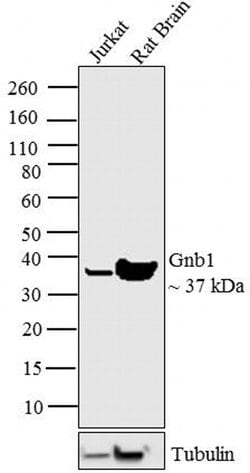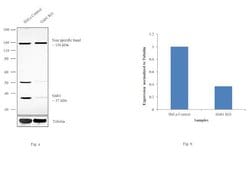Learn More
Invitrogen™ Gnb1 Polyclonal Antibody
Rabbit Polyclonal Antibody
Supplier: Invitrogen™ PA1725
Description
PA1-725 detects transducin beta (T beta) from sheep, bovine, mouse and drosophila. PA1-725 has been successfully used in Western blot procedures. By Western blot, this antibody detects an ~37 kDa protein representing Tr beta from sheep and bovine retinal and optic nerve extracts as well as mouse eye samples and drosophila. The PA1-725 immunizing peptide corresponds to amino acid residues 8-25 from human Tr beta. This sequence is completely conserved between human, amphibian, bovine and rat. PA1-725 immunizing peptide (Cat. # PEP-154) is available for use in neutralization and control experiments.
Vision involves the conversion of light into electrochemical signals that are processed by the retina and subsequently sent to and interpreted by the brain. The process of converting light into an electrochemical signal begins when the membrane-bound protein, rhodopsin, absorbs light within the retina. Photoexcitation of rhodopsin causes the cytoplasmic surface of the protein to become catalytically active. In the active state, rhodopsin activates transducin, a GTP binding protein. Once activated, transducin promotes the hydrolysis of cGMP by phosphodiesterase (PDE). The decrease of intracellular cGMP concentration causes the ion channels within the outer segment of the rod or cone to close, thus causing membrane hyperpolarization and, eventually, signal transmission. Rhodopsin activity is believed to be shut off by phosphorylation followed by binding of the soluble protein, arrestin. Transducin, once activated by rhodopsin, promotes the hydrolysis of cGMP by PDE. The subunit composition of transducin differs between different photoreceptor cells. Rod transducin consists of rod transducin alpha (Tr alpha), T beta, and T gamma. Cone transducin is composed of cone transducin alpha (Tc alpha), T beta and T gamma. Differential transducin subunit composition of transducin is believed to be responsible for the different light sensitivities between photoreceptive cells.
Specifications
| Gnb1 | |
| Polyclonal | |
| Unconjugated | |
| GNB1 | |
| AA409223; beta subunit, signal-transducing proteins GS/GI; C77571; G protein subunit beta 1; gbb1; GNB1; Gnb-1; gnb1 protein; gnb1a; guanine nucleotide binding protein (G protein), beta 1; guanine nucleotide binding protein (G protein), beta polypeptide 1; guanine nucleotide binding protein (G protein), beta polypeptide 1a; guanine nucleotide binding protein, beta 1; Guanine nucleotide-binding protein beta 1; guanine nucleotide-binding protein G(I)/G(S)/G(T) subunit beta-1; guanine nucleotide-binding protein, beta-1 subunit; MRD42; T beta; testicular tissue protein Li 72; transducin beta chain 1; transducin beta subunit; unnamed protein product; wu:fb50b09; wu:fj94h04 | |
| Rabbit | |
| Antigen affinity chromatography | |
| RUO | |
| 101104166, 14688, 24400, 2782, 281201 | |
| -20°C, Avoid Freeze/Thaw Cycles | |
| Liquid |
| Western Blot | |
| 1 mg/mL | |
| PBS with 1mg/mL BSA and 0.05% sodium azide | |
| P54311, P62871, P62873, P62874 | |
| GNB1 | |
| Synthetic Peptide: R(8) Q E A E Q L K N Q I R D A R K A C(25). | |
| 100 μg | |
| Primary | |
| Human, Mouse, Rat, Bovine, Sheep, Drosophila | |
| Antibody | |
| IgG |
Your input is important to us. Please complete this form to provide feedback related to the content on this product.



